This last September, Moody Center for the Arts at Rice University in Houston opened up its newest exhibition and residency project with New York City-based artist Matthew Ritchie. Ritchie’s exhibition Demon in the Diagram is part of Rice University’s ongoing cross-campus and community effort to create transformative encounters with the arts. Ritchie’s site-specific installation explores history, human nature, and time diagrams that thread through multi-layered mythologies and allegories. Ritchie’s work here — through interactive soundscapes, movable paintings, VR technology, and wall works — allows the viewer to explore methods for mapping history and science. Glasstire contributor Paul Middendorf spent a recent morning with Ritchie in Houston to dig a little deeper into his process, and chat about his cumulative experiences of making and showing work in Texas.
Paul Middendorf: Tell us about the exhibition, how it came about, and your process as it unfolded (upon your re-investigation of Texas).
Matthew Ritchie: Alison Weaver [Executive Director of Rice University’s Moody Center for the Arts] offered a project around the time the center was being built. At the time I was working on a project at ICA Boston, where they asked me to work with every department within the ICA. I was thinking about that process as a model for being an artist. What consists of the boundary of work or of artistic activity? [It’s] a conversation that has gone right back to the Bauhaus or dating back to the renaissance. What constitutes the limits in an exhibition?
We talked about Rice as an interdisciplinary opportunity, and where the Moody Center would be set up to explore the role as a reflection of a “site.” It’s a site-specific project in the sense [of] formal terms, or the way the details of the space are an analysis of the building itself. The elements are made for it and literally printed onto the surface of the building. We started locating fabricators and began to think about the idea making everything locally, and using local resources. We really wanted to use this space as a platform and to make it resonate with different communities.
I met with the mathematics, architecture, art history, drawing, computer science, and other departments to see what might be of interest. What degree can a space can be perceived of and used as a resonance chamber for other conversations? Where they legitimately overlap rather than performing in a space that is different, to really seek out a collaborative resonance? There is not just the physical ramp-up, but the knowledge ramp-up, so the information environment is receptive and there is alignment.
PM: This is a very site-specific dialogue with the Moody Center. Was there any experiences or past visits to Houston or Texas that you were harvesting from? For instance, with your project you did with the Contemporary Arts Museum Houston (2003-4), or with other artists or art spaces you had worked with locally?
MR: The thing I’ve found about the projects here in Texas is that people have a very progressive attitude towards art regardless of their political philosophy. There is a tremendous openness here toward experimentation. Also a tremendous pragmatism. These are not qualities found uniformly when living in New York. There is a very Texas “ Go Big or Go Home” kind of vibe. The CAMH was very much that kind of project. The CAMH was like: “Just go for it.” There is a real pragmatic quality to it that is the NASA side of Texas.
PM: Most of the major Texas cities can act as separate base camps [for art], compared to the rest of the state. Texas can be perceived as having its own political collective agenda. We have key cities acting as research facilities of innovative ideas hosting our creative or scientific minds. There is a synergy throughout cities like Houston, Dallas, Austin, San Antonio, and our Marfa sector out west. You referenced this creative nervous system in your walk-through; can you elaborate more on this idea?
MR: That is very different than other Southern and Western states. I think that is a quality of Texas. Maybe it’s like that everywhere? Very polarized from the rural to the urban forms, but I think it’s a very unique Texas quality — this “Can Do” attitude. There are plenty of states in the South and West that have big cities where nothing happens. They are politically blue and allegedly progressive, but they don’t have a research enterprise. There are plenty of collectors and philanthropist here being highly functional, generous, and contributive towards the research that might be surprisingly red, and they might have voted very differently. However, they are still very interested in what I would say is “the arc of progress.” That isn’t very true in a lot of Northeastern states, where we have a much more uniform voting block. You still have the rural/urban divide, but you also have an ossification of urban centers where there is not a very generous donor class.
PM: Houston is indeed collaborative, progressive, and very willing to “Git ‘er Done.” I agree that you don’t always find that in other cities. You said, during your walk-through, that you had a lot of freedom to do what you are not normally allowed to do with bigger institutions or other museums. Would you say you feed off of that, and worked from that first impression when you came here the first time? That you could work differently?
MR: Definitely! One of the nicest things about the project has been meeting all the different contributors. This is where doing an information-based project over time starts to become really rewarding. I got to meet people who are 86 years old who were at Rice University when it was just fields. I got to meet the kids at Rice who were eating dinner under the beautiful Brochstein Pavilion. Then you meet the Brochsteins, who were here in the beginning, and they wanted to give back an entirely different experience. You get to see this generational responsibility. It’s like Houston is very much a big city, but has a very small-town pride in itself. There is also that big-city idea of no boundaries. For me it’s super interesting about Houston specifically, but Texas in general — it still has a frontier-type of quality.
PM: Texas certainly communicates that to those visiting for the first time. You adapt to this fresh new quality and it integrates into what we are all producing.
MR: Yeah, that is a very American quality, but coming from Europe and England you think of Texas as the most American of American states. It’s the cowboy state. It’s the Space Program state. It’s where all the crazy limit conditions happen. You end up with the super hurricanes, the border fences, super-progressive, super-conservative, super-everything, super-sized. Everything has a ten-gallon hat on it here (laughs). As opposed to Connecticut. Then you’re like: Who really cares what happens in Connecticut? No one says “As Connecticut goes, so goes the nation.”
PM: So with the project, you were collaborating with all the departments, entities, the people at Rice, and pulling from these notions of Texas and its unique qualities. And utilizing our local resources and fabricators rather than having the work done out of state or back in New York. Can you talk a little about how that worked for you?
MR: I did a project at the Getty Institute [in Los Angeles] that concluded a year and a half ago. As I reached the end, I realized I didn’t want to be an archivist. Some projects are about this giant archive. For me what was interesting is then what do you do with the knowledge? That is a historical problem that repeats across disciplines. By proposing something as we move through history, we develop models of thought. The spirit of each civilization governs its productive enterprise. There is a kind of music in that, over time, and we are just the latest version of that.
We are at a moment where our theory of picture — the picture of ourselves — evolved in the 20th century, and we held on for too long. The story of human history is one of dramatic change or point of view. It’s us regretting that we have to lose our connection to the past. You get this ongoing transition on building the next picture and the collapse of the existing one. That is the state that is at odds with any institution that is not designed for exploring probabilities. It’s not how the art world works. The art world oscillates between museums that are designed to maintain this record of the past, and this temporary experimentalism. It’s not a rap on museums; they just aren’t research institutes.
Once you are in dialogue with all these different groups, you are almost obliged to think about these more complex ideas of picture making. There aren’t even very many institutions that would support a project like that. Alison often describes the Moody Center as a building for whom the mission is being constructed along with the program. That’s a unique situation — to be in an institution that does not have that specific, predetermined idea of itself.
PM: It’s been fascinating — to have walked through the exhibition on my own, and then again with you. Unlike most exhibitions where you’re given a linear path to follow with titles and didactics, I felt lost within the pictorial language and diagrams surrounding me. One could pull information out of what you have presented, and it becomes an intriguing journey to decode the rest. You say that the viewer may never absorb all of the information you have included.
The VR experience you created is the perfect example of this. [The viewer is] instructed to wear a tunic and a Greek-inspired masked attached to a headset. You enter into your realm of diagrams. You have the possibility of 25 different lectures that you can hear while drifting through endless data. Describe this path within the project.
MR: I contribute that to the context of the Moody Center. If you make something for an art audience and their expectations, you lead them, through wall labels, and how they experience the art. If you say this is an interdisciplinary research project, you free yourself of the burden. Maybe it’s about music, maybe it’s about dance, or a piece about mathematics, while at the same time it’s a piece about exploring 20th-century art forms of the immersive installation. The tradition that goes from Duchamp to Joseph Beuys to Sigmar Polke, questioning what art is and its limitation.
One way to do that is to think about it in the eyes of someone who is not an artist, but creative like a mathematician, scientist, or historian. You are looking at a totally different story that maps onto the history of art, but has completely different priorities. [Here] we come into the fullness of the digital age, where Wikipedia is something you might look at to [becoming] something students are being forbidden from just copying because it’s become so endemic as a source. It’s a layer of information that attaches to everything. Everything is footnotes now. That is something we are at the beginning of, not the end or the middle of. That is the permission from art, to step out of the provisional set of boundaries of art as an aesthetic experience.
If you go into the James Turrell installation here, there is this beautiful skyscape above you. Every time, there is a handful of people sitting on the bench, reading their [cel phone] texts. So to think of those two things as separate, which is the conventional art way of thinking of them — they are now part of one ecosystem. How do we make art that accepts its continuity with the information landscape? This project is about that sense of potentiality, but it’s going to be difficult for most. We are attached to this model of art as a form of picturesque. This is all something that would not appeal to James Turrell — thinking of people sitting in his space texting. That sucks, for it’s certainly not the purpose of the space. There is always this long list of things you aren’t supposed to do.
This show is another way of doing that, in a way — where that Wikipedia world is just a question of dislocation.
PM: Experiencing these projects through a several-inch sized screen is what so much art is today. Whether it’s a dance performance or installation, individuals feel this is how they need to experience it, only to look back at it all to find poor audio and image quality that doesn’t represent what happened at all. You mentioned Demons in the Diagram and how we have the internet and this form of data that is supposed to create more information for us and fluidity. Then through platforms like Facebook and Instagram, information is fragmented. Data is no longer linear — it is convoluted and filled with misinformation. We are second guessing the information we get through the Web.
How have you implemented these ideas into this installation?
MR: It always has been everywhere. The wall drawings have clay pencil referencing ancient wall drawings, for both materials are basically mud. Then you have virtual reality, which is more or less a cell phone glued to your eyes. I was hoping to achieve the totality of informational forms. There has always been too much information to process and always a need for a system to handle it.
Then you see, from time to time, these systems collapse. We are just [in] a hyper-accelerated moment of that. At the same time, if you go to Hindu temple covered in gods, drawings, and diagrams, you don’t understand that it’s a similar dense environment of information that you are trying to make sense of.
For me, the impetus is for us to open ourselves to this complexity of the problem and step into it. [We think that if] we don’t understand it, it’s not understandable. We retreat to our own boxes. You can always step back into a childhood book, but the challenge is to step forward. To accept it, and see patterns within it, without trying to determine them as an answer. It’s all something we are capable of figuring our way out of.
PM: You speak of the many moving parts within this collaboration. Tell us about the alternative programs you have created at Rice University for this exhibition. You have scheduled dance, music, and performance as well as [working with and] teaching classes.
MR: I’ve been teaching eight different classes, with more to come. For instance, for the class Art Installation in the 21st Century, we brought the class in to see the show as it was progressing, as opposed to seeing the show once it was completed. The common denominator within the classes is “process.” There would be no show without the building, the people that come to view it, the individuals who turn it on, and off again at the end of the day — it’s all part of the experience and can only be truly observed over time. If you come in to see the show for 20 minutes and walk out again, you think it’s just like that. A magic trick.
These are shared spaces physically [and] informationally. If you don’t show how the space exists, or why it exists, then there is no continuity. That is the engagement that Alison proposed, and why this is really valuable to me as an artist. The production of co-reality is something that is rarely offered upfront. It’s usually so temporary, like a restaurant. You aren’t thinking about all the restaurants. You don’t want to think about where it all comes from, or where it all goes. You don’t want to! In a residency, you are committed to the experience. Then the project is fed by this inclusion and involvement, rather than taking away from it.
PM: This brings up a valuable point: You are here on a residency. You are living here in Houston, and coming back and forth. You have an apartment and are teaching classes. You are now in Texas and involved, as opposed to flying in once for the install and again for a few appearances.
MR: Yes, for sure. The residency essentially started in the spring. I’ve gotten to have these layers of experiences and want to create a form of an echo. A show like this can produce a string of echoes. I always think of these projects as having, at a minimum, a 30-percent split between the run up, the actual experience, and post experience. There is a fullness to the experience.
PM: And you’ve been granted a flexibility that most artists don’t get with a typical exhibition. You created the base or foundation for the show, and then you continued to work on it through its duration. This model seems to be where you are most comfortable. Would you agree?
MR: Of course. The show I had at the CAMH was very much like that other model, where it was a traveling show hitting multiple cites, but we had a moment of flexibility in the beginning. That past exhibition started here in Houston, and we got to experiment a little bit with it and formulate “What can we ask of people?” There were interactive and procedural parts to it, and we were figuring it out as we were forming the show.
I think this is why many artists chose to work with galleries, and find it to be so productive. Although a particular show goes up and down, you have this relationship that goes on for decades. You end up living with those people, and it’s really nice because they become part of your life. You know, like the idea of the restaurant model. If you don’t like the soup, you just send it back. If you’re working on a project with someone for two years, you just can’t send the soup back. It doesn’t get you anywhere and isn’t a helpful scenario.
I get to keep revisiting and fine tuning upon each visit [to] Texas, and build upon the project, but also those relationships. I like to think that Alison thinks of me as an active component of the show. I’ve never performed in my own work. So when Alison insisted I was the voice within the VR experience, it was a completely unique for me. It was also horrifying. That is the sort of suggestion that may not have happened if we had a shorter amount of time, with these pop-in/pop-out relationships. I had time to think about it and have that discourse with them about it.
PM: The exhibition wraps up at the end of December, and I understand you are sticking around a bit longer to work on another project here in the state?
MR: That is correct. I am working at the University of North Texas [in Denton] on a garden that will be installed next year for their new School of Visual Arts and Design. It’s a huge new department, one of the largest of its kind. What is interesting with this particular project is it’s only art. There is no crossover conversation with other disciplines. So how do you make a piece that is strictly about the idea of art? I am just beginning the process of that. I love how these projects have come together and formed. It’s what I love about Texas. It’s so big and weird. It’s the Texas go-to.
PM: Wait until you get over to the NASA complex. There are rocket scientist walking around with lab coats and snakeskin boots! Right up your alley.
MR: It’s why I enjoy Texas so much — because you have this real sense of no limits!
This interview has been edited for length and clarity.
Through December 22, 2018 at Moody Center for the Arts at Rice University, Houston


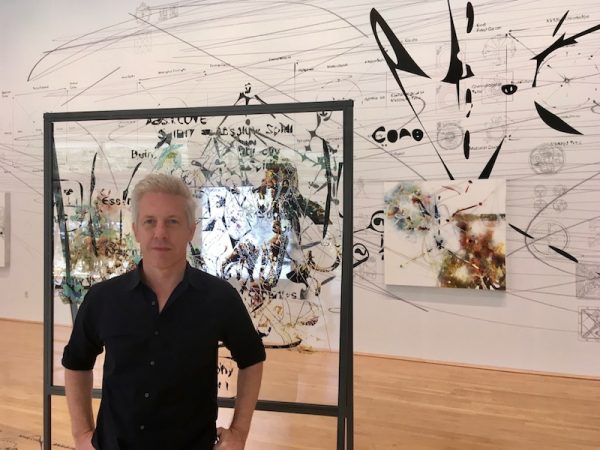
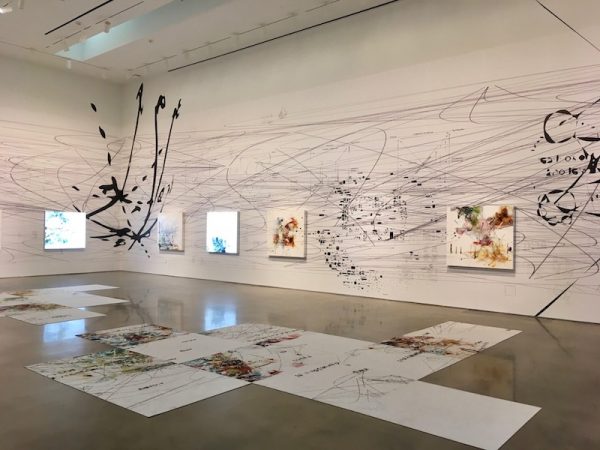

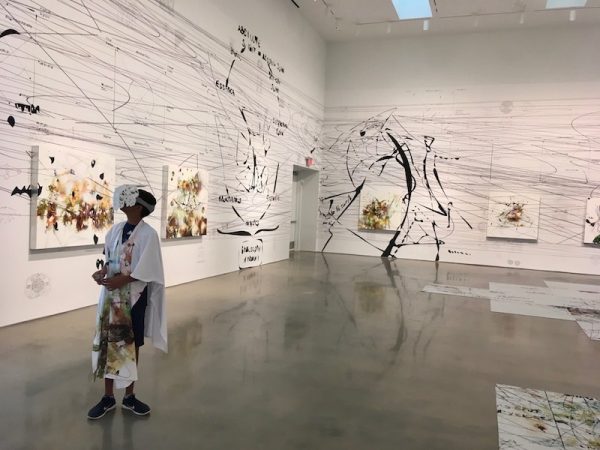
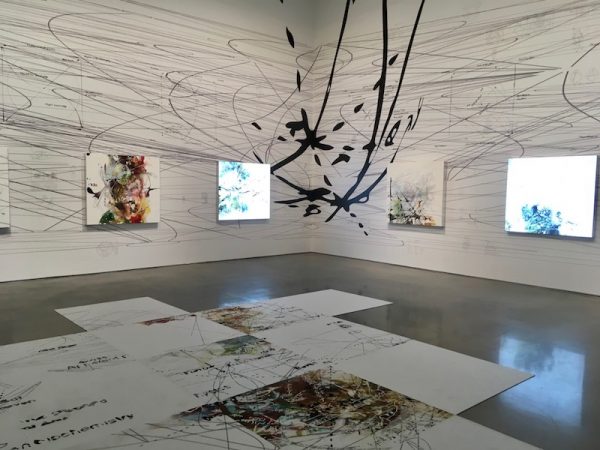
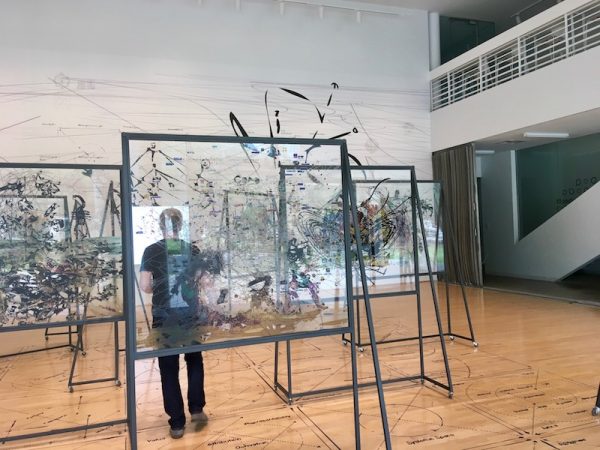

1 comment
Yep, Matthew has been coming to Texas for a long time. Loved working with him when I was the DMA (Concentrations 38: Matthew Ritchie, The Slow Tide) in the winter of 2001. Thrilled to see he is producing work that is even more brilliant, beautiful and joyously accessible and inaccessible at the same time. I often remind myself of a quote of his about not “getting” a work of art. It goes something like, “you do not have to get a tree to find it beautiful.”